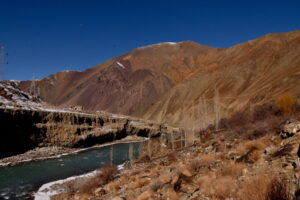 In the dense Himalayan folds of Uttarakhand, where the Nayar River once flowed with grace and abundance, there is now a troubling silence. Water thins, vegetation withers, and in some places, the once-lush slopes show little new plant growth. While grazing has been absent here for decades, signs of disrupted natural regeneration are everywhere.
In the dense Himalayan folds of Uttarakhand, where the Nayar River once flowed with grace and abundance, there is now a troubling silence. Water thins, vegetation withers, and in some places, the once-lush slopes show little new plant growth. While grazing has been absent here for decades, signs of disrupted natural regeneration are everywhere.
This ecological imbalance is not isolated.
Scientific studies have long suggested that regulated grazing, rather than bans, plays a crucial role in ecosystem health. A 2010 paper in Ecology Letters found that controlled grazing helps maintain biomass balance, improve nutrient cycling, and support diverse vegetation. In the Valley of Flowers in Chamoli, a blanket ban on grazing led to a troubling shift dominant grasses took over, biodiversity shrank, and fire risks surged.
Supporting this, research published in Plant and Soil (2003) and Conservation Biology (2005) observed similar biodiversity loss in regions where grazing was entirely halted.
Experts now advocate for rotational, seasonal grazing to restore natural balance, reintroduce traditional ecological rhythms, and reduce the risk of wildfires and invasive species.
Nayar’s Collapse: A Mirror of Himalayan Crisis
But the deeper crisis lies in the river itself. The Nayar, once a vital artery of the Garhwal hills, is now gasping. According to a 2017–18 study by India’s Department of Science and Technology, nearly 50% of perennial water sources in the Himalayan region have dried up or suffered sharp decline.
In the Nayar basin, the causes are tangled: weakening of traditional forest-community bonds, neglect of ancient water systems like khals and chals, farmland abandonment, and a policy shift to centralised, contractor-driven models of water management. Government schemes like Har Ghar Nal and Har Ghar Jal now extract water from distant locations, while ignoring the revival of traditional sources.
Over 50 pumping stations pull water from the Nayar, but what returns is mostly untreated waste. Climate change, declining groundwater recharge, and haphazard urbanisation compound the crisis. The golden mahseer, an iconic fish species of the river, is nearing extinction a living indicator of the Nayar’s failing health.
The Yatra That Became a Movement
In response to this unfolding crisis, a unique ecological pilgrimage the Nayar River Yatra set out to rediscover the river’s meaning. Two groups journeyed along the Eastern and Western tributaries of the Nayar to their confluence at Satpuli, before walking together to Vyasghat. But this was not just a walk; it was a revival of lost relationships.
Through folk songs, rituals, intergenerational dialogues, and community pledges, the yatra brought river conservation back into the emotional landscape of the people. Villagers were not passive spectators but active participants, voicing memories, stories, and commitments to revive their river.
The yatra culminated in a set of deeply rooted recommendations:
•Afforestation using native, biodiversity-rich species
•Revival of traditional, seasonal grazing practices
•Restoration of community-managed water sources like khals and chals
•Integrated and culturally sensitive river basin management
River as Memory, Culture, and Future
What the Nayar River Yatra revealed is profound: ecological conservation is not only a scientific or policy-driven process it is cultural, emotional, and spiritual. The river is not just a water body; it is a thread that stitches together villages, forests, festivals, songs, and livelihoods. It is a memory keeper and a life-giver.
Saving the Nayar and countless other non-glacial rivers of the Himalayas is not just about pumps, pipes, or plans. It requires restoring bonds: between people and rivers, between tradition and sustainability, between memory and action.
As Himalayan rivers dry and climate change tightens its grip, the lessons from the Nayar are clear. Development must be reimagined. Community voices must be centered. And our bond with nature must be healed.
In saving the Nayar, we are not just preserving a river. We are reclaiming a civilisation.
